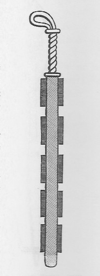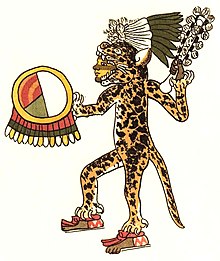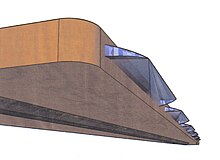Obsidian sword
| Obsidian sword | |
|---|---|

|
|
| Information | |
| Weapon type: | Percussion weapon |
| Designations: | Maquahuitl, Macquahuitl, Maccuahuitl, Maquahiutl |
| Use: | weapon |
| Creation time: | before the 16th century |
| Working time: | til today |
| Region of origin / author: |
Aztecs and other peoples |
| Distribution: | Mesoamerica |
| Overall length: | approx. 90 cm - 120 cm |
| Blade width: | approx. 10 cm - 12 cm |
| Handle: | Wood |
| Lists on the subject | |

Obsidian swords are club-like cutting weapons with blades or splinters of obsidian incorporated into the sides . They were used by the peoples of Central America . The Aztec name for the obsidian sword is Macuahuitl ( Nahuatl ). Other orthographic variants are Maquahuitl , Macquahuitl , Maquahiutl or Maccuahuitl . The meaning is roughly: "Handholz".
Knowledge of the obsidian sword is based exclusively on reports and illustrations from the period up to the 16th century. There are no archaeological finds.
Manufacturing
Although the weapon is referred to as a "sword", it is more like a paddle . The weapon was 10-12 cm wide and about 0.9-1.20 meters long. There were rectangular, egg-shaped or pointed shapes. The two-handed obsidian sword has been described by eyewitnesses as " as tall as a man ". During production, obsidian blades were glued in with resin on both sides . Gaps were often left on one side between the obsidian blades. In this way, larger wounds could be inflicted on the enemy, like with a saw. On the other side, the obsidian blades were sometimes placed close together so that they formed a uniform cutting edge.
use

Obsidian swords were used exclusively as a cutting weapon. The obsidian sword was used one-handed or two-handed. Unlike with swords made of metal, it did not make sense to “cross the blades ”. This would have broken the obsidian blades.
Above all in the context of the Flower Wars , the weapon was used to injure the enemy, to take him prisoner and later to offer human sacrifices. According to Bernal Díaz del Castillo , one of the conquistadors of Hernán Cortés , it was also possible to kill a horse with this weapon:
“ When Pedro de Moron and other horsemen broke into the enemy lines, they snatched the lance from him and seriously wounded him with their swords. His mare received a blow in the neck and collapsed dead. "
Compared to the Spanish weapons, however, the obsidian sword had disadvantages. It takes more time, a heavy "paddle" to lift and swing, with a well-balanced as a sword to thrust. The actual fighting also takes up more space, so the Aztec warriors stood side by side in a loose row, while the Spanish fought in a compact group.
See also
literature
- Elizabeth Baquedano: Aztec, Inca & Maya. Knopf, New York NY 1993, ISBN 0-679-93883-4 ( Eyewitness Books ).
- Michael D. Coe: Mexico. Thames & Hudson, London 1962 ( Ancient Peoples and Places 29, ZDB -ID 418077-x ).
- Bernal Díaz del Castillo : History of the Conquest of Mexico. Edited and edited by Georg A. Narciß. Insel-Verlag, Frankfurt am Main 1988, ISBN 3-458-32767-3 ( Insel-Taschenbuch 1067), (Spanish original title: Historia verdadera de la conquista de la Nueva España ).
- Ross Hassig: Aztec Warfare. Imperial Expansion and Political Control. University of Oklahoma Press, Norman OK et al. 1988, ISBN 0-8061-2121-1 ( The Civilization of the American Indian Series 188).
- Peter James, Nick Thorpe: Ancient inventions. Ballantine Books, New York NY 1994, ISBN 0-345-36476-7 .
- Gustav Friedrich Klemm : Allgemeine Cultur-Geschichte der Menschheit , Volume 5, Teubner-Verlag, 1847, entry: "Schwert, Maquahiutl", p. 81
- Michael E. Smith: The Aztecs. Reprinted (twice). Blackwell, Malden MA et al. 1996, ISBN 1-55786-496-9 ( The Peoples of America ).
- Soustelle, Jacques (1961). Daily Life of the Aztecs: On the Eve of the Spanish Conquest, Patrick O'Brian (Trans.), London: Phoenix Press. ISBN 1-84212-508-7 .
- Jacques Soustelle : Daily life of the Aztecs on the eve of the Spanish conquest. Weidenfeld & Nicolson, London 1961 (also: Phoenix Press, London 2002, ISBN 1-84212-508-7 ).
- Richard F. Townsend: The Aztecs. Revised edition. Thames & Hudson, London 2000, 0-500-28132-7 ( Ancient Peoples and Places 107).

